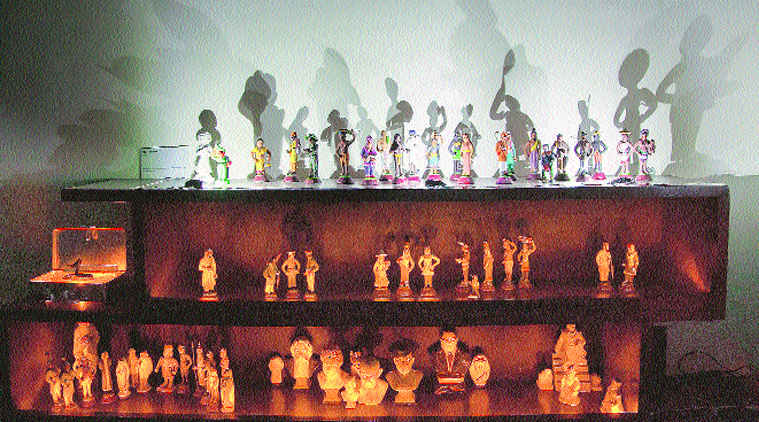The Identity Hangover: Archana Hande challenges the stereotypes of Indians
In her latest show, artist Archana Hande challenges the stereotypes of Indians that were perpetrated by the British.
 Using clay models, Hande talks about community-based stereotype. (Photo by Archana Hande)
Using clay models, Hande talks about community-based stereotype. (Photo by Archana Hande)
A few months ago, Archana Hande was browsing through the collection of the Bhau Daji Lad Museum in Mumbai. It comprised diverse clay models of Indian people — Parsis, Brahmins, Kolis, Baniyas, Sikhs and Sindhis, among other communities. The figures, crafted in detail right down to the jewellery, costume and mannerisms were a part of a larger project commissioned by the British in the late 1800s to help them understand Indians better. The classification was based on what the Indians wore, what they ate and what their professions were. Looking at the models of the fisherfolk Kolis and the Marwaris with account books in hand, Hande realised the long-term ramifications of the project.
“By viewing Indians in a particular way based on dress, food and occupation, the British gave us an identity. Over the 18th, 19th and 20th centuries, the Indians modelled themselves accordingly. Then the British left, but the foundation for our identity was laid,” says Mumbai-based Hande. In response to the collection of the museum, the Mumbai-based artist is showcasing her work titled, “POI (People of India)/Bharat Ke Log”, curated by Tesneem Mehta, at the museum till October 26 where she talks of Indians not getting over the colonial “identity hangover”.
In the context of an identity crises, Hande delves into community-based stereotypes. “Anyone from the southern states is a South Indian. Gujaratis, Maharashtrians and North Indians are all slotted into stereotypes that we have carried with us for years,” she says. For research, Hande bought school charts that hang in classrooms with photographs of the people of India. “There was no difference in the representation of these communities now and 100 years ago. The Northeastern people were still drawn as tribals and farmers were shown with cattle they used for agriculture. I thought it was about time we shrugged off these stereotypes,” she says.
Hande, who graduated from Santiniketan in West Bengal and earned a postgraduate degree from MS University of Baroda in printmaking, presents a contemporary take on her subject. The Special Project Space, where her work is displayed, has been darkened and feels “peaceful like a shrine, where these issues may be laid to rest”. To the right, are arranged clay models that Hande has personally collected. It is an interesting mix — there are Maratha warriors, farmers, busts of Mahatma Gandhi and Mother Teresa and an occasional modern-day construction worker as well.
Hande’s highlight piece for the show makes the strongest statement. In the centre of the room a large mosquito net is draped like a canopy. The net was an important import at the time and is synonymous with the British rule. It is laced with drawings of Indians from the museum’s
collection. While some drawings adhere to cliches, others look urban, almost worldly.
The net is a protection. The biggest irony is the colonialists are not placing it anymore, we’re doing it to ourselves. We need to ask ourselves why we are still protecting identity-based stereotypes. I’m trying to start a dialogue with the works. Identity covers a wide range of issues, from gender and religion to occupation and politics. There can be no discussion on these, without being free from stereotypes,” she adds.






- 01
- 02
- 03
- 04
- 05





















